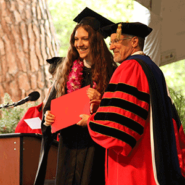The Running Leap

Have you ever seen a child jump over a stream?
They don’t usually walk up to the stream, stop, and try to jump from there. They walk up, stop, and then back up far enough to get a running start. Backing up enables them to take a running leap and successfully clear the stream without falling in and getting wet.
In that situation, you would never mistake a child backing up to take a running leap as backing away. No parent would stop them and say, “Get back up there, and try again!” It’s obvious that they’re backing up to get what they need to succeed.
That makes backing up an integral part of the forward motion.
But what about other situations?
Here’s a scenario I saw twice one summer at two different swimming pools when the Running Leap first occurred to me. If you watch for it this summer you will see it, too.
A little girl sees a big slide that sends kids flying into the pool with a splash! It looks like fun, so she goes up to the top, looks down, freezes with fear, then heads back down the stairs. Her concerned parent runs over and tries to convince her that it isn’t scary at all. “It will be fun! Look, that little boy just did it, and he’s laughing!”
The child isn’t having any of it, and despite her parent’s warnings that she can’t go back down the stairs “because kids are lined up there,” she finds her way down and heads straight to the little slide intended for younger children.
The parent, trying to save her child from being left out in the future when all her friends are going down the big slide and she can’t (we do this!), by saying things like, “That slide is for babies! You don’t want people to think you are a baby, do you?”
Luckily, children always set the right level of challenge for their own growth, so despite her parent’s protests, the child continues to play on the smaller slide.
If you are worried, this could look like procrastination, avoidance, or regression, and confirm your worst fears. But when you know that the child is backing up instead of backing away, you can watch with confidence for signs of progress as she goes down the little slide over and over.
When you do you will see her moving from sliding tentatively to racing down headfirst. The little slide is the perfect place to build up her confidence and skills. Forward motion is always there if you know to look for it.
Plus, while mastering the little slide, she will probably also be stealing glances at the kids going down the big slide—learning by watching as all kids do. When she finally starts picturing herself in their place, she will get up, go back to the big slide, and go down it, all on her own! Time after time, that’s how the Running Leap works.
No pushing is needed. The drive to take challenges and the knowledge of what’s needed to master them is innate in children (and in us).
Understanding the Running Leap enables you to confidently sit back and watch as your child backs up to get what they need to succeed. Offering support instead of criticism becomes easy with Language of Listening®:
SAY WHAT YOU SEE: “You decided you needed more practice before going down the big slide. You found just the place. Look at you go down that little slide headfirst! Now you’re watching the other kids…”
STRENGTH: “You’ll know when you are ready to try the big slide again.”
Our fears and criticism result in children backing up even farther; encouragement helps them run forward more quickly and succeed twice as fast.
When you watch for it, you will see the Running Leap in all learning situations, at all ages.
For example, my daughter Betsy just earned her M.A. in Positive Developmental Psychology, and along the way she experienced two major Running Leaps. Recognizing the backing up that came with them as an integral part of her forward motion helped me support her with minimal fear.
The first was in 10th grade when she decided to pursue the difficult curriculum that her sister, Colleen, was completing—International Baccalaureate (IB). She took AP US History as the first course. She’d seen the long hours her sister spent poring over the books on her own and with a study group, but thought it would take her less time since she was a highly proficient reader.
This was an important point for Betsy since she was (and still is) a very social person. She thrived in social situations. Her growth from challenges required spending a lot of free time with friends to recharge and gain strength.
As it turned out, the course was just as time-consuming for her as it was for her sister. This, combined with several other challenging classes, meant that for the entire school year she had very little time for friends, and as the year wore on I saw how stressful that was for her.
When it came time to register for Junior year courses, as hard as it was for her to step out of something she had already begun (she loves to complete things and is a high achiever), she decided not to continue the IB program. We all swallowed hard, but knew it was the right thing.
Thank goodness I understood the Running Leap, because the following year—the “most important” academic year for college applicants—she spent more time with friends than with school work. I had to keep reminding myself that this was her backing up to get what she needed to succeed in college in a couple of years.
I was right. After a year of what I might otherwise have seen as “goofing off,” she took her senior year and the next four years of college seriously. She buckled down and stayed with it. I truly believe that without that Junior year of backing up and getting the social time she needed, she would not have been able to continue straight on to college.
Then, after four more hard years of study to earn her B.A. in Psychology, came the next Running Leap. Instead of going straight on to graduate school for her Masters, which she knew she needed to work in her field, she took a year off. She moved to Florida near her cousin, worked a minimum-wage job, and spent most of her time on the beach.
Having seen her earlier Running Leap, I worried even less this time and was able to encourage and support her, knowing this was exactly what she needed to be able to succeed in whatever she did next, whether it was returning to school or not.
I have to say I was tickled to see how well it worked. She told us that while doing the dishes one day when her year-off was coming to a close, this thought just popped into her head, “I’m going to get a Ph.D.” Challenges work like that. They show up seemingly out of nowhere when you’re ready.
Her M.A. marks the three-year point in the Ph.D. program she’s enrolled in. Thanks to her two major Running Leaps, she is still on her way.





